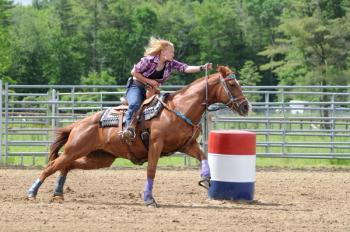
Equine field surgery: Head and neck surgery (Proceedings)
Rostral Mandibular & Maxillary Fractures: Fractures of the rostral mandible and premaxilla/incisive bones that can be repaired with wire or acrylic.
Head & Neck Surgeries
Lip lacerations
• Intra-oral wire fixation of rostral mandibular and maxillary fractures
• Tracheotomy
• Tracheostomy
• Staphylectomy (Partial resection of the soft palate)
• Sternohyoideus myectomy and sternothyroideus tenectomy
• Modified Forssell's Operation for Cribbing
Rostral Mandibular & Maxillary Fractures
• Indications – Fractures of the rostral mandible and premaxilla/incisive bones that can be repaired with wire or acrylic.
• Equipment – 16 or 18 gauge stainless steel wire
– needle holders or pliers
– wire cutters
– Acrylic
– Drill
• Ideally, a nasotracheal tube is placed during the surgery
Anatomy
• The structures potentially involved are:
– premaxilla (incisive bone)
– incisive part of the mandible
– Incisors
– canine teeth
– mental and infra-orbital nerves
– the intermandibular synchondrosis
– permanent tooth roots
Surgical procedure
• Thorough debridement of the fracture site
• Maintain loose deciduous teeth if possible
• "freshen" the edges of exposed bone with a bone curette
• Fractures that involve 4 or fewer incisors can generally be repaired with cerclage wire fixation techniques
• A minimum of two loops
• wires should engage a minimum of three teeth
• Ideally, there should be overlap
• A 14-16-gauge hypodermic needle or 2.0 mm drill hole used as a guide
• wires are bent flat +/- covered with acrylic
• When necessary, additional stabilization can be achieved by securing the corner incisor(s) to the exposed canine or second premolar
Post-operative management
• Generally no problems eating, but a pelleted feed or gruel may be of benefit
• Rinse mouth at least 2X/day for the first week
• Consider antibiotic therapy
• NSAIDs are typically administered for 1-3 days
• No grazing for 2-4 weeks
• Check wires regularly for breakage
Complications • purulent drainage
• bone sequestration
• septic osteitis
• difficult mastication
• unusual incisor eruption
• wire loosening
• fixation failure
Tracheotomy
Indications
• to establish an emergency airway due to an upper airway obstruction
• to relieve nasal or laryngeal inflammation
• route for endotracheal intubation for general anesthesia
• to "rest" an inflamed upper respiratory tract
Anatomy • paired sternomandibularis and sternothyrohyoideus
• trachea
Surgical procedure
• A 6-8 cm ventral midline incision
• Incise subcutaneous tissues
• Separate paired sternothyrohyoideus mm
• Minimize blunt dissection to decrease subcutaneous emphysema and seroma
• Tracheal rings identified and a transverse stab incision is made between two rings
• The incision is extended from midline 1-2 cm in both directions (~1/3 the circumference of the lumen)
• A tracheotomy tube is then placed.
Post-operative management
• Tracheotomy tubes require almost continuous monitoring and management
• Clean tubes & sites at least daily
• Exudate and blood clots should be removed with a dry, sterile sponge and the skin surrounding the site should be cleaned
• Extra tubes should be immediately available
• The wound is allowed to heal by second intention with daily cleaning
• Petroleum jelly to prevent scalding
• Healing is generally complete in 2-3 weeks
Complications - Subcutaneous emphysema, Hemorrhage, Inflammation
Rare complications - Tracheal obstruction or stricture, Granulomas, Chondromas, Pneumothorax
Tracheostomy
• Indications – any permanent disorder of the larynx and upper trachea in which airflow is impaired
• Equipment – No special equipment is required. Self-retaining retractors are desirable
Anatomy • paired sternomandibularis, sternothyrohyoideus, omohyoideus
• ventral trachea.
Surgical Procedure
• A 10-12 cm ventral midline incision
• Avoid previous tracheotomy site
• The cutaneous colli and the paired sternohyoideus muscles separated on midline and retracted laterally to expose a section of 3-4 tracheal rings
• Sections of the paired sternohyoideus muscles may be removed to minimize the tension on the tracheal mucosa/skin junction during subsequent closure.
• A midline and 2 paramedian incisions are made in the exposed tracheal rings
• avoid incising tracheal mucosa
• rectangular segments dissected free of mucosa
• mucosa incised in a double-Y pattern
• Stay sutures are placed to align and prevent retraction of the mucosa
• mucosa is then apposed to the skin using a simple interrupted pattern
• close all gaps between mucosal edges or between mucosa and skin
Post-operative management
• stall rest 2 weeks with controlled hand walking only
• clean surgery site 1-2 times daily until the sutures are removed and once daily indefinitely
• anti-inflammatory and antibiotic therapy recommended for 1-2 days
• sutures are removed in 10-14 days
Complications
• partial dehiscence of the tracheal mucosa-skin suture line
• excessive inflammation
• granulation tissue formation
• stricture
• skin growth or apposition over the tracheostomy site
• coughing
• Long term complications include coughing during exercise, stridor, and exercise induced dyspnea
Staphylectomy (Partial resection of the soft palate)
• Indications
– intermittent or permanent dorsal displacement of the soft palate (DDSP)
– The procedure is often used in conjunction with a sternothyrohyoideus myectomy and/or epiglottic augmentation
Equipment • Gelpi or Weitlaner self-retaining retractor
• Allis tissue forceps
• long-handled or right-angle scissors
• curved sponge forceps
Anatomy • performed through a laryngotomy
• Important landmarks
– paired sternohyoideus muscles
– v-shaped cricothyroid membrane which lies between the thyroid and cricoid cartilages.
Surgical Procedure
• ventral midline laryngotomy through the cricothyroid membrane
• 8-10 cm incision is made starting at the cranial border of the thyroid cartilage and extending caudal to the first tracheal ring
• The paired sternohyoideus muscles are identified and separated longitudinally the length of the incision
• A self-retaining retractor is inserted between the muscle bellies to expose the fascia overlying the cricothyroid membrane
• The caudal border of the thyroid cartilage and the cranial border of the cricoid cartilage are identified
• self-retaining retractors are then repositioned within the larynx
• Free edge of soft palate grasped on midline with Allis tissue forceps
• Tissue removed is either crescent shaped; approximately 3-4 cm long, 6-10 mm wide at the center and tapered to a point on either ends, or a small equilateral triangle of tissue is removed with each side measuring ~8-10 mm.
• Laryngotomy incision left to heal by 2nd intention
Post-operative management
• Broad spectrum antibiotics and NSAIDS are administered for 2-5 days
• The incision site is cleaned at least once daily with moistened sterile sponges
• Petroleum jelly is applied around the incision to minimize scalding from the anticipated drainage
• Stall rest with controlled hand-walking only for 2 weeks to allow the inflammation of the soft palate to subside. The horse may then return to its normal activity.
Complications • recurrence
• development of granulation tissue at the edge of the palate
• dysphagia if too much of the caudal palate is removed
Sternothyrohyoideus Myectomy and Sternothyroideus Tenectomy
• Indications – Intermittent (DDSP) which causes temporary exercise intolerance
• Equipment – Rochester-Carmalt forceps, Straight Péan forceps with longitudinal serrations, an angiotribe or similar instrument
– Penrose drain may be used in the myectomy procedure.
– A spay hook may be useful for the sternothyroideus tenectomy procedure.
Surgical Procedure
• The section of muscle removed varies:
– from very rostral
– to as far caudal as the separation of the sternomandibularis mm
Post-operative care
• antibiotics and NSAIDs
• towel stent or neck bandage for 2-4 days after surgery
– protects the wound
– provides counter pressure to reduce edema, hematoma, and seroma formation
• stall rest for at least 1 week with controlled hand walking followed by return to normal exercise over the next 2-3 weeks
• Penrose drain removed in 2-3 days.
Complications • seroma or hematoma formation
• incisional infections
• incisional dehiscence
• reuniting of the severed ends of the muscles through scar formation
Modified Forssell's Operation for Cribbing
• Indications – The primary indication for this procedure is modification of cribbing behavior when non-surgical methods fail
• Special Equipment – Large Rochester-Carmalt, Straight Péan or angiotribe forceps
– Penrose drain
Anatomy
• The ventral branch of the spinal accessory nerve is located on the dorsomedial aspect of the sternomandibularis and enters the muscle about 5 cm from the muscle tendon junction
Surgical Procedure
• A 30 cm ventral midline incision is made starting 2 cm rostral to the larynx at the basihyoid bone and extending caudally.
• Dissect between the omohyoideus and the sternomandibularis to expose the medial aspect of the sternomandibularis 5 cm caudal to the musculotendinous junction.
• Contraction of the sternomandibularis muscle and flexion of the head is observed when the nerve is pinched with hemostats
• A 5-10 cm section of nerve is exposed using blunt dissection and removed
• A sternothyroideus tenectomy and sternohyoideus myectomy is performed as previously described
• Penrose drain +/- towel stent may inhibit post-op swelling and seroma formation
Post-operative management
• stall rest with controlled hand walking for at least 1 week
• return to normal exercise over the next 2-3 weeks
• Antibiotic therapy for 24 hours after drain removal
• Phenylbutazone - 2-3 days
• Stent removed ? 2 days
• Penrose drain removed 2-5 days
Complications • failure to resolve the behavioral abnormality
• seroma or hematoma formation
• incisional infections
• incisional dehiscence
References
Adams SB, Fessler JF, editors: Atlas of Equine Surgery, Philadelphia, 2000, WB Saunders Co.
Auer JA, Stick JA, editors: Equine Surgery, 3rd ed. Philadelphia, 2006, WB Saunders Co.
McIlwraith CW, Robertson JT, Turner AS, editors: Equine Surgery: Advanced Techniques, 2nd ed. Ames, IA, 1998, Blackwell Publishing.
McIlwraith CW, Robertson JT, Turner AS, editors: Equine Surgery, 2nd ed. Philadelphia, 1998, Lippincott Williams & Wilkins.
Wilson DA, Kramer J, Constantinescu GM, Branson KR, editors. Manual of Equine Field Surgery, St Louis, 2006, Elsevier.
Newsletter
From exam room tips to practice management insights, get trusted veterinary news delivered straight to your inbox—subscribe to dvm360.






